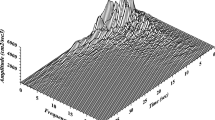Abstract
Accurate estimation of the peak seismic responses of structures is important in earthquake resistant design. The internal force distributions and the seismic responses of structures are quite complex, since ground motions are multi-directional. One key issue is the uncertainty of the incident angle between the directions of ground motion and the reference axes of the structure. Different assumed seismic incidences can result in different peak values within the scope of design spectrum analysis for a given structure and earthquake ground motion record combination. Using time history analysis to determine the maximum structural responses excited by a given earthquake record requires repetitive calculations to determine the critical incident angle. This paper presents a transformation approach for relatively accurate and rapid determination of the maximum peak responses of a linear structure subjected to three-dimensional excitations within all possible seismic incident angles. The responses can be deformations, internal forces, strains and so on. An irregular building structure model is established using SAP2000 program. Several typical earthquake records and an artificial white noise are applied to the structure model to illustrate the variation of the maximum structural responses for different incident angles. Numerical results show that for many structural parameters, the variation can be greater than 100%. This method can be directly applied to time history analysis of structures using existing computer software to determine the peak responses without carrying out the analyses for all possible incident angles. It can also be used to verify and/or modify aseismic designs by using response spectrum analysis.
Similar content being viewed by others
References
Der Kiureghian A (1981), “A Response Spectrum Method for Random Vibration Analysis of MDF Systems,” Earthquake Engineering and Structural Dynamics, 9:419–435.
Habibullah A and Wilson EL (1996), “SAP2000 User’s Manual,” Computers & Structures, Inc.
Hernández JJ and Lopez OA (2002), “Response to Three-component Seismic Motion of Arbitrary Direction,” Earthquake Engineering and Structural Dynamics, 31:55–77.
López OA and Torres R (1997), “The Critical Angle of Seismic Incidence and the Maximum Structural Response,” Earthquake Engineering and Structural Dynamics, 26:881–894.
Penzien J and Watabe M (1975), “Characteristics of 3-Dimensional Earthquake Ground Motion,” Earthquake Engineering and Structural Dynamics, 4:489–496.
Semby W and Der Kiureghian A (1985), “Modal Combination Rules for Multicomponent Earthquake Excitation,” Earthquake Engineering and Structural Dynamics, 13:1–12.
Wilson EL, Der Kiureghian A and Bayo EP (1981) “A Replacement for the SRSS method in Seismic Analysis,” Earthquake Engineering and Structural Dynamics, 9:87–194.
Author information
Authors and Affiliations
Corresponding author
Additional information
Supported by: U.S. Federal Highway Administration Under Grant No. DTFH61-98-C-00094; U.S. National Science Foundation Under Grant No. CMS-9701471
Rights and permissions
About this article
Cite this article
Song, J., Liang, Z., Chu, YL. et al. Peak earthquake response of structures under multi-component excitations. Earthq. Eng. Eng. Vib. 6, 357–370 (2007). https://doi.org/10.1007/s11803-007-0777-4
Received:
Accepted:
Issue Date:
DOI: https://doi.org/10.1007/s11803-007-0777-4




